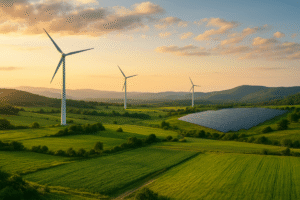As we struggle with the challenges of climate change, the term “carbon offsetting” frequently pops up in conversations. But what does it mean exactly? Carbon offsetting is a practical, hands-on approach to combat climate change. It allows individuals and companies to invest in environmental projects worldwide to balance out their carbon footprints.
When you offset your carbon emissions, you’re effectively counteracting your emission contributions by ensuring an equivalent amount of greenhouse gas is either removed from the atmosphere or prevented from getting there in the first place.
In this article, we’ll delve deeper into the world of carbon offsetting and credible climate finance, crucial tools in our global transition to net-zero emissions. Let’s navigate this complex yet rewarding landscape together!
Table of Contents
Different types of carbon offsets and how they work
Carbon offsetting isn’t a one-size-fits-all solution. It comes in various shapes and forms, each with its unique method of reducing or eliminating greenhouse gas emissions.
- Renewable energy projects: These offset projects aim to reduce the reliance on fossil fuels by generating power from renewable sources like wind, solar, or hydropower. Investing in these projects can increase the percentage of global energy derived from sustainable sources, decreasing our overall carbon emissions;
- Methane capture projects: Methane, a potent greenhouse gas, is often released during waste decomposition in landfills. Methane capture projects aim to trap this gas and convert it into energy, preventing its harmful release into the atmosphere;
- Forestry and reforestation projects: These involve the planting of trees or the preservation of forests. Trees naturally absorb CO2 from the atmosphere, reducing the overall concentration of greenhouse gases;
- Energy efficiency projects: These initiatives aim to lower the energy demand by promoting more efficient technology or processes. Reducing energy consumption directly correlates to less fossil fuel burned to produce that energy, thereby reducing CO2 emissions.
Importance of carbon offsetting in the global transition to net-zero
Transitioning to a net-zero world is a monumental task. It involves shifting our energy production to renewable sources, transforming our transportation systems, and fundamentally changing the way we live and work. Despite our best efforts, it’s unlikely we’ll be able to reduce all emissions entirely. That’s where carbon offsetting enters the scene.
It also serves as a critical bridge in our global transition to net-zero. By neutralizing emissions that we can’t eliminate, it ensures we’re still making progress toward our environmental goals. Moreover, it’s a mechanism that allows us to take immediate action. While structural changes to our economy and infrastructure may take years, even decades, to achieve, carbon offsetting can start reducing global CO2 levels today.
Through carbon offsetting, businesses and individuals can positively impact by supporting projects that reduce or absorb greenhouse gas emissions. It’s a way of taking responsibility for our carbon footprint and making a tangible contribution to the fight against climate change.
Challenges and Criticisms of Carbon Offsetting
While carbon offsetting is a valuable tool in our fight against climate change, it is not without its critics. One of the key criticisms is the potential for greenwashing. Some entities may use carbon offsetting to appear more environmentally friendly without making substantial changes to their operations or behaviors.
There’s also the challenge of ensuring the integrity of offset projects. The effectiveness of these projects can vary, and some might not deliver the promised emission reductions. Others might displace environmental harm rather than alleviate it—for example, a reforestation project that results in the eviction of local communities.
Additionally, the concept of carbon offsetting is sometimes criticized as a distraction from the necessary work of reducing emissions at the source. Critics argue that instead of compensating for emissions, the focus should be on avoiding them in the first place.
Future of carbon offsetting and climate finance
As we struggle with the climate crisis, the future of carbon offsetting and climate finance looks promising. Rapid advancements in technology and increased public awareness are driving new trends.
The rise of blockchain, for example, brings transparency and traceability to carbon credits, enhancing their credibility. Similarly, the development of AI and remote sensing technologies can help verify the impact of offset projects, making sure they deliver on their promises.
The scope of climate finance is also expanding. Beyond carbon offsetting, it’s growing to encompass investments in green technologies and infrastructure. These initiatives reduce emissions, create jobs, and stimulate economic growth. The emphasis is shifting towards a holistic approach, where climate action goes hand in hand with social and economic development.
Read also: Carbon neutrality: what is it and how to reach it












